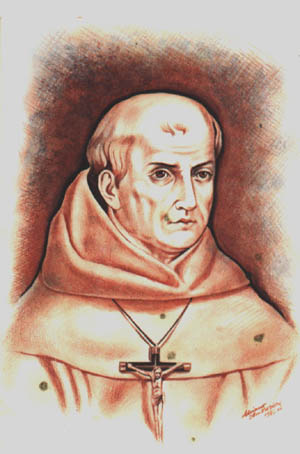|
BORN
MIGUEL JOSE SERRA ON THE Spanish Island of Mallorca, Father Junipero Serra
is probably the best known of all the Franciscan mission priests. Described
as a small man (only 5 feet, 2 inches tall), it was said that Padre Serra
made up for his lack of stature with his enormous heart.
By 1771, at the age of 58, the good padre moved into Mission Carmel.
He had overseen much of the missionization of California through his high
ideals and pragmatic nature. An asthmatic all of his life, and in his
last years suffering a unhealable wound on his leg, Serra's love of the
California Indians was legendary. When many of his fellow priests would
have resorted immediately to strict and formal punishment in the face
of neophyte opposition, Father Serra was known to administer the whip
only when all else failed.
By August of 1784, Padre Serra was ill and saw the end coming.
He sent for his good friend Padre Francisco Palou. Father Palou prepared
him for death. The Indians gathered outside his room. Finally, on August
28, 1784, the good padre died. As Padre Palou prepared the body for burial,
he came and went from the room. Upon returning in the evening, Padre Palou
was horrified to see that the Padre Serra's heart had been removed from
his body. Fearing that greater harm would come should others know of the
deed, Padre Palou quickly dressed the body for burial and arranged for
internment the next day.
The fate of Padre Serra's heart of was not unique to him alone.
Within the next twenty years, nearly fifty-percent of the padres who passed
away had their hearts removed under mysterious circumstances. Through
much investigation, the Franciscans were able to surmise the cause of
such radical acts: the Mission Indians, it was revealed, had established
a secret network throughout the California mission system whose very charter
was the removal of as many of the hearts of the deceased padres as was
possible. It was the price the padres would pay for their work. Knowing
that a body which was not intact would forever be restless in the afterlife,
the Indians removed and hid the hearts from as many of the padres as possible.
It was not until the early part of the following century that Padre Serra's
heart turned up on the mission steps, preserved in a jar of brandy.
To this day, missions and historical museums throughout California
are full of the cut-out hearts of mission padres, on display for visitors
to peruse.
RELATED LINKS
With regards to Junipero Serra, here are but a few of the possible sites
one might encounter on the web. By simply Googling his name, 520,000 hits
come up. Although the scholarship is yet to be completed, one suggestion
is that there are more statues of Junipero Serra in California than of
any other person.
Junipero Serra School
http://www.juniperoserra.org/
Joaquin Murrietta's Head in a Jar
http://en.wikipedia.org/wiki/Joaquin_Murietta
http://www.sptddog.com/sotp/jomu.html
http://www.joaquinmurrieta.com/
Ishi the Last Yahi Indian's Brain in a Jar
http://www.nmnh.si.edu/anthro/repatriation/projects/ishi.htm
http://www.thebicyclingguitarist.net/ishi/
http://www.ucsf.edu/daybreak/1999/02/19_ishi.html
http://groups.msn.com/ONEOFMANYFEATHERS/ishithelastyahi.msnw
Account of Louis the XVII of France's Heart in a Jar
http://en.wikipedia.org/wiki/Louis_XVII_of_France
|

